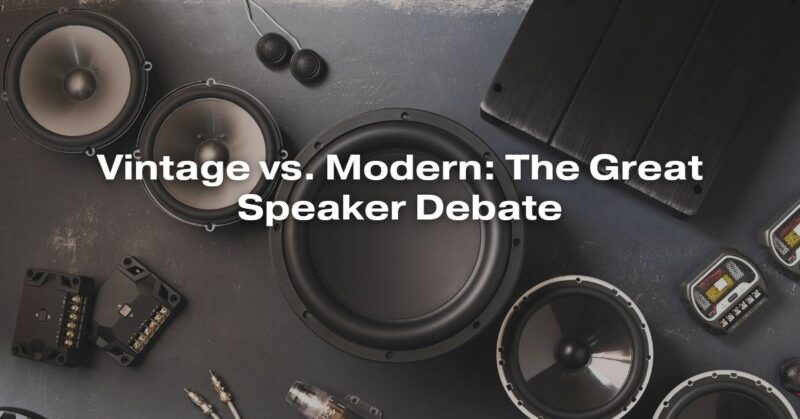Music is a universal language that transcends time and culture. Whether you’re an audiophile, a casual listener, or a professional musician, the quality of your audio equipment plays a crucial role in your musical experience. Among the various components of a sound system, speakers are arguably the most essential. In the world of audio enthusiasts, a spirited debate has raged for years: vintage speakers vs. modern speakers. Each side has its own merits and devoted followers, making it a fascinating topic to explore.
The Evolution of Speaker Technology
To understand the vintage vs. modern speaker debate, it’s essential to delve into the evolution of speaker technology.
Vintage Speakers
Vintage speakers, typically from the mid-20th century and earlier, are revered for their craftsmanship and iconic designs. These speakers often feature paper or wood cone drivers, heavy cabinets made from solid wood, and intricate grill designs. Notable examples include the Klipschorn, Altec Lansing Voice of the Theatre, and the JBL L100. Vintage speakers offer a sense of nostalgia and historical significance, and many audiophiles believe they have a warm, organic sound that is hard to replicate with modern technology.
Modern Speakers
Modern speakers, on the other hand, benefit from decades of technological advancement. They incorporate cutting-edge materials, design principles, and manufacturing techniques. Today’s speakers often feature lightweight but rigid materials like Kevlar, aluminum, and carbon fiber for driver cones, as well as advanced computer modeling for precise tuning. Modern speakers aim to provide a more accurate and transparent representation of the audio source, striving for a flat frequency response and minimal distortion.
The Sound Quality Debate
Sound quality is at the heart of the vintage vs. modern speaker debate.
Vintage Sound Quality
Vintage speakers are often associated with a warm and colored sound signature. They may add a pleasant distortion or coloration to the audio, which some listeners find appealing. The limitations of older technology, such as limited frequency response and higher distortion, contribute to this unique sound. Audiophiles who favor vintage speakers argue that this coloration can enhance the listening experience, especially for certain genres like classic rock or jazz.
Modern Sound Quality
Modern speakers, on the other hand, strive for accuracy and transparency. They aim to reproduce audio as faithfully as possible, without introducing any additional coloration or distortion. This approach is preferred by those who prioritize an unaltered, studio-quality listening experience. Modern speakers often provide a wider frequency response, lower distortion, and improved dispersion, making them suitable for various musical genres and audio applications.
Practical Considerations
Beyond sound quality, several practical considerations come into play when choosing between vintage and modern speakers.
Availability and Maintenance
Vintage speakers, especially iconic models, can be challenging to find in good condition. They may require extensive restoration and maintenance, including reconing speakers, replacing capacitors, or refinishing cabinets. Modern speakers are readily available and come with warranties, making them a more convenient choice for many consumers.
Compatibility
Modern speakers are designed to work seamlessly with modern audio equipment, such as AV receivers, amplifiers, and digital signal processors. Vintage speakers may require additional adapters or modifications to be compatible with newer technology, potentially adding to the overall cost.
Aesthetics
Aesthetics play a significant role in the vintage vs. modern speaker debate. Vintage speakers often have a unique, retro charm that can enhance the visual appeal of a room. Modern speakers, on the other hand, tend to have a sleek, minimalist design that may better complement contemporary interiors.
The Subjectivity of Audio Preference
Ultimately, the choice between vintage and modern speakers is highly subjective and depends on individual preferences. Audiophiles, musicians, and casual listeners all have unique tastes and priorities when it comes to sound quality and aesthetics. Some may appreciate the warm, colored sound of vintage speakers, while others may prefer the precision and transparency of modern ones.
The Future of Audio
As technology continues to advance, the vintage vs. modern speaker debate may evolve. Hybrid designs that combine vintage aesthetics with modern technology are already emerging, catering to a niche market of enthusiasts who want the best of both worlds. Additionally, the rise of digital signal processing and room correction technologies has the potential to further blur the lines between vintage and modern sound quality.
In conclusion, the vintage vs. modern speaker debate is a testament to the enduring passion and enthusiasm of audio enthusiasts. Both vintage and modern speakers have their unique qualities and advantages, and the choice ultimately depends on your personal preferences, budget, and the specific audio experience you seek. Whether you’re a fan of vintage classics or a believer in modern precision, one thing remains certain: the pursuit of the perfect sound will continue to drive innovation in the world of audio technology.

